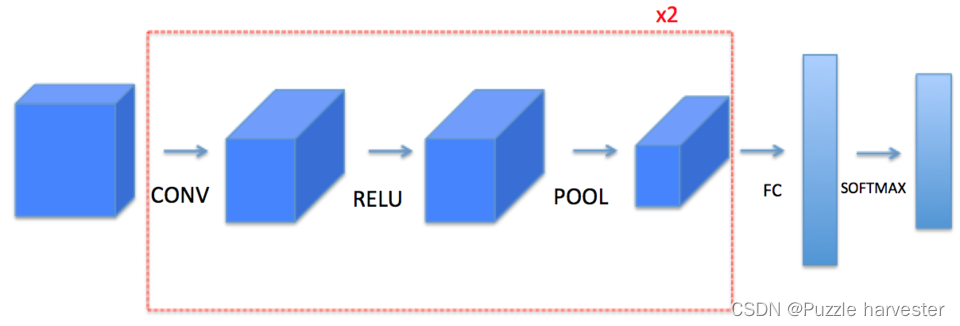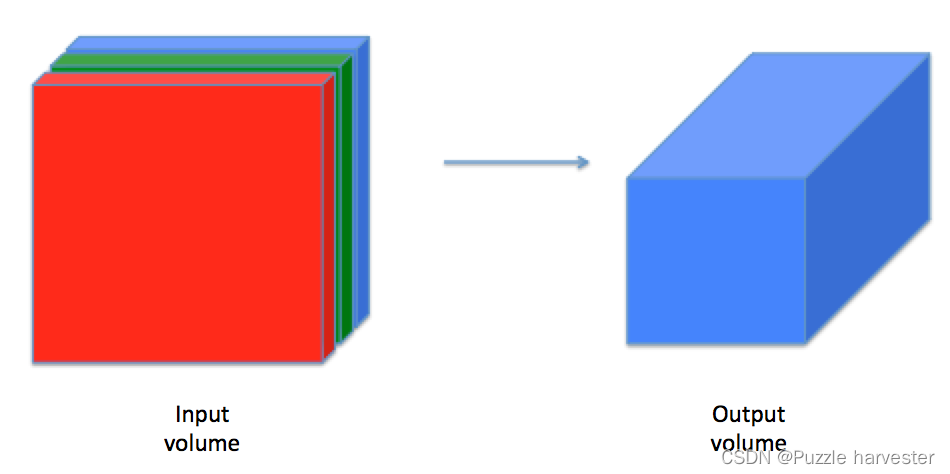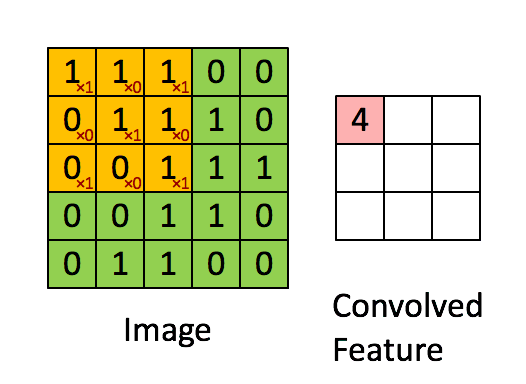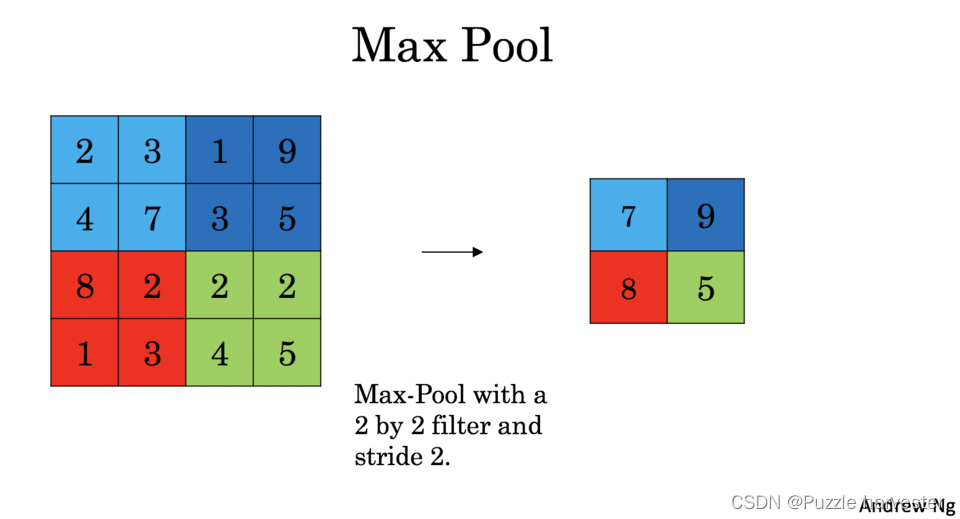-
Python吴恩达深度学习作业11 -- 卷积神经网络的实现
逐步实现卷积神经网络
在此作业中,你将使用numpy实现卷积(CONV)和池化(POOL)层,包括正向传播和反向传播。
符号:
- 上标
[
l
]
[l]
[l] 表示第
l
t
h
l^{th}
lth 层的对象.
- 例如: a [ 4 ] a^{[4]} a[4] 是 4 t h 4^{th} 4th 层的激活. W [ 5 ] W^{[5]} W[5] 和 b [ 5 ] b^{[5]} b[5] 是 5 t h 5^{th} 5th 层的参数。
- 上标
(
i
)
(i)
(i) 表示第
i
t
h
i^{th}
ith个示例中的对象。
- 示例: x ( i ) x^{(i)} x(i)是 i t h i^{th} ith个训练数据的输入。
- 下标
i
i
i表示
i
t
h
i^{th}
ith的向量输入。
- 示例: a i [ l ] a_i^{[l]} ai[l]表示 l l l层中的 i t h i^{th} ith个激活,假设这是全连接层(FC)。
- n H n_H nH, n W n_W nW和 n C n_C nC分别表示给定层的通道的高度,宽度和数量。如果要应用特定层 l l l,则还可以写入 n H [ l ] n_H^{[l]} nH[l], n W [ l ] n_W^{[l]} nW[l], n C [ l ] n_C^{[l]} nC[l]。
- n H p r e v n_{H_{prev}} nHprev, n W p r e v n_{W_{prev}} nWprev 和 n C p r e v n_{C_{prev}} nCprev分别表示前一层的高度,宽度和通道数。如果引用特定层 l l l,则也可以表示为 n H [ l − 1 ] n_H^{[l-1]} nH[l−1], n W [ l − 1 ] n_W^{[l-1]} nW[l−1], n C [ l − 1 ] n_C^{[l-1]} nC[l−1]。
我们假设你已经熟悉numpy或者已经完成了之前的专业课程。那就开始吧!
1 安装包
让我们首先导入在作业过程中需要用到的包:
- numpy 是Python科学计算的基本包。
- matplotlib 是在Python中常用的绘制图形的库。
- np.random.seed(1)使所有随机函数调用保持一致。这将帮助我们为你的作品评分。
import numpy as np import h5py import matplotlib.pyplot as plt %matplotlib inline plt.rcParams['figure.figsize'] = (5.0, 4.0) # set default size of plots plt.rcParams['image.interpolation'] = 'nearest' plt.rcParams['image.cmap'] = 'gray' %load_ext autoreload %autoreload 2 np.random.seed(1)- 1
- 2
- 3
- 4
- 5
- 6
- 7
- 8
- 9
- 10
- 11
- 12
- 13
2 作业大纲
你将实现构建卷积神经网络的需要的模块!要求实现的每个函数都有详细的说明,以帮助你完成所需的步骤:
- 卷积函数,包括:
- 零填充
- 卷积窗口
- 正向卷积
- 反向卷积(可选)
- 池化函数,包括:
- 正向池化
- 创建mask
- 分配值
- 反向池化(可选)
本笔记本将要求你使用 numpy从头开始实现这些函数。在下一本笔记本中,你将学习使用TensorFlow来实现:

注意,对于每个正向函数,都有其对应的反向等式。因此,在正向传播模块的每一步中,都将一些参数存储在缓存中。这些参数用于在反向传播时计算梯度。
3 卷积神经网络
尽管编程框架可以方便使用卷积,但它们仍然是深度学习中最难理解的概念之一。卷积层将输入体积转换为不同大小的输出体积,如下所示。

在这一部分,你将构建卷积层的每一步。首先实现两个辅助函数:一个用于零填充,另一个用于计算卷积函数本身。
3.1 零填充
零填充将在图像的边界周围添加零:

图像(3个通道,RGB),填充2次。
填充的主要好处有:
- 允许使用CONV层而不必缩小其高度和宽度。这对于构建更深的网络很重要,因为高度/宽度会随着更深的层而缩小。一个重要、特殊的例子是"same"卷积,其中高度/宽度在一层之后被精确保留。
- 有助于我们将更多信息保留在图像边缘。如果不进行填充,下一层的一部分值将会受到图像边缘像素的干扰。
练习:实现以下函数,该功能将使用零填充处理一个批次X的所有图像数据。使用np.pad()。注意,如果要填充维度为 ( 5 , 5 , 5 , 5 , 5 ) (5,5,5,5,5) (5,5,5,5,5)的数组"a",则第二维的填充为
pad = 1,第四维的填充为pad = 3,其余为pad = 0,你可以这样做:a = np.pad(a, ((0,0), (1,1), (0,0), (3,3), (0,0)), 'constant', constant_values = (..,..))- 1
def zero_pad(X, pad): X_pad = np.pad(X, ((0,0), (pad, pad), (pad, pad), (0, 0)), 'constant', constant_values=0) return X_pad- 1
- 2
- 3
- 4
np.random.seed(1) x = np.random.randn(4, 3, 3, 2) x_pad = zero_pad(x, 2) print ("x.shape =", x.shape) print ("x_pad.shape =", x_pad.shape) print ("x[1,1] =", x[1,1]) print ("x_pad[1,1] =", x_pad[1,1]) fig, axarr = plt.subplots(1, 2) axarr[0].set_title('x') axarr[0].imshow(x[0,:,:,0]) axarr[1].set_title('x_pad') axarr[1].imshow(x_pad[0,:,:,0])- 1
- 2
- 3
- 4
- 5
- 6
- 7
- 8
- 9
- 10
- 11
- 12
- 13
x.shape = (4, 3, 3, 2) x_pad.shape = (4, 7, 7, 2) x[1,1] = [[ 0.90085595 -0.68372786] [-0.12289023 -0.93576943] [-0.26788808 0.53035547]] x_pad[1,1] = [[0. 0.] [0. 0.] [0. 0.] [0. 0.] [0. 0.] [0. 0.] [0. 0.]] <matplotlib.image.AxesImage at 0x1cbdcdbbf60>- 1
- 2
- 3
- 4
- 5
- 6
- 7
- 8
- 9
- 10
- 11
- 12
- 13
- 14
- 15
- 16
- 17
- 18

3.2 卷积的单个步骤
在这一部分中,实现卷积的单个步骤,其中将滤波器(卷积核)应用于输入的单个位置。这将用于构建卷积单元,该卷积单元:
- 占用输入体积
- 在输入的每个位置都应用滤波器
- 输出另一个体积(通常大小不同)

图2:卷积操作
滤波器大小为 2 × 2 2 \times 2 2×2,步幅为1(步幅 = 每次滑动窗口的数量)
在计算机视觉应用中,左侧矩阵中的每个值都对应一个像素值,我们将 3 × 3 3 \times 3 3×3滤波器与图像进行卷积操作,首先将滤波器元素的值与原始矩阵相乘,然后将它们相加。在练习的第一步中,你将实现卷积的单个步骤,相对于仅对一个位置应用滤波器以获得单个实值输出。
在本笔记本的后面,你将应用此函数于输入的多个位置以实现完整的卷积运算。
练习:实现conv_single_step()。
def conv_single_step(a_slice_prev, W, b): s = np.multiply(a_slice_prev, W) + b Z = np.sum(s) return Z- 1
- 2
- 3
- 4
- 5
np.random.seed(1) a_slice_prev = np.random.randn(4, 4, 3) W = np.random.randn(4, 4, 3) b = np.random.randn(1, 1, 1) Z = conv_single_step(a_slice_prev, W, b) print("Z =", Z)- 1
- 2
- 3
- 4
- 5
- 6
- 7
Z = -23.16021220252078- 1
3.3 卷积神经网络–正向传递
在正向传递中,你将使用多个滤波器对输入进行卷积。每个“卷积”都会输出一个2D矩阵。然后,你将堆叠这些输出以获得3:

练习:实现以下函数,使用滤波器W卷积输入A_prev。此函数将上一层的激活输出(对于一批m个输入)A_prev作为输入,F表示滤波器/权重(W)和偏置向量(b),其中每个滤波器都有自己的(单个)偏置。最后,你还可以访问包含stride和padding的超参数字典。
提示:
- 要在矩阵"a_prev"(5,5,3)的左上角选择一个 2 × 2 2 \times 2 2×2切片,请执行以下操作:
a_slice_prev = a_prev[0:2,0:2,:]- 1
使用定义的start/end索引定义a_slice_prev时将非常有用。
- 要定义a_slice,你需要首先定义其角点
vert_start,vert_end,horiz_strat和horiz_end。该图可能有助于你找到如何在下面的代码中使用h,w,f和s定义每个角。

图3:使用垂直和水平的start/end( 2 × 2 2 \times 2 2×2滤波器)定义切片
该图仅显示一个通道。
提醒:
卷积的输出维度与输入维度相关公式为:
n H = ⌊ n H p r e v − f + 2 × p a d s t r i d e ⌋ + 1 n_H = \lfloor \frac{n_{H_{prev}} - f + 2 \times pad}{stride} \rfloor +1 nH=⌊stridenHprev−f+2×pad⌋+1
n W = ⌊ n W p r e v − f + 2 × p a d s t r i d e ⌋ + 1 n_W = \lfloor \frac{n_{W_{prev}} - f + 2 \times pad}{stride} \rfloor +1 nW=⌊stridenWprev−f+2×pad⌋+1
n C = number of filters used in the convolution n_C = \text{number of filters used in the convolution} nC=number of filters used in the convolution
对于此作业,我们不必考虑向量化,只使用for循环实现所有函数。def conv_forward(A_prev, W, b, hparameters): (m, n_H_prev, n_W_prev, n_C_prev) = A_prev.shape (f, f, n_C_prev, n_C) = W.shape stride = hparameters['stride'] pad = hparameters['pad'] n_H = 1 + int((n_H_prev + 2 * pad - f) / stride) n_W = 1 + int((n_W_prev + 2 * pad - f) / stride) Z = np.zeros((m, n_H, n_W, n_C)) A_prev_pad = zero_pad(A_prev, pad) for i in range(m): a_prev_pad = A_prev_pad[i] for h in range(n_H): for w in range(n_W): for c in range(n_C): # 找到当前“切片”的角 vert_start = h * stride vert_end = vert_start + f horiz_start = w * stride horiz_end = horiz_start + f # 使用边角来定义a_prev_pad的(3D)切片(参见单元格上方的提示)。 a_slice_prev = a_prev_pad[vert_start:vert_end, horiz_start:horiz_end, :] # 将(3D)切片与正确的滤波器W和偏置b进行卷积,得到一个输出神经元。 Z[i, h, w, c] = np.sum(np.multiply(a_slice_prev, W[:, :, :, c]) + b[:, :, :, c]) assert(Z.shape == (m, n_H, n_W, n_C)) cache = (A_prev, W, b, hparameters) return Z, cache- 1
- 2
- 3
- 4
- 5
- 6
- 7
- 8
- 9
- 10
- 11
- 12
- 13
- 14
- 15
- 16
- 17
- 18
- 19
- 20
- 21
- 22
- 23
- 24
- 25
- 26
- 27
- 28
- 29
- 30
- 31
- 32
- 33
- 34
- 35
- 36
- 37
- 38
np.random.seed(1) A_prev = np.random.randn(10,4,4,3) W = np.random.randn(2,2,3,8) b = np.random.randn(1,1,1,8) hparameters = {"pad" : 2, "stride": 1} Z, cache_conv = conv_forward(A_prev, W, b, hparameters) print("Z's mean =", np.mean(Z)) print("cache_conv[0][1][2][3] =", cache_conv[0][1][2][3])- 1
- 2
- 3
- 4
- 5
- 6
- 7
- 8
- 9
- 10
Z's mean = 0.15585932488906465 cache_conv[0][1][2][3] = [-0.20075807 0.18656139 0.41005165]- 1
- 2
最后,CONV层还应包含一个激活,此情况下,我们将添加以下代码行:
# Convolve the window to get back one output neuron Z[i, h, w, c] = ... # Apply activation A[i, h, w, c] = activation(Z[i, h, w, c])- 1
- 2
- 3
- 4
4 池化层
池化(POOL)层减少了输入的高度和宽度。它有助于减少计算量,而且可以使特征检测器在输入中的位置保持不变。池化层有两种:
- 最大池化:在输入上滑动 ( f , f ) (f,f) (f,f)窗口,并将窗口的最大值存储在输出中。
- 平均池化:在输入上滑动
(
f
,
f
)
(f,f)
(f,f)窗口,并将窗口的平均值存储在输出中。


这些池化层没有用于反向传播的参数。但是,它们具有超参数,例如窗口大小 f f f,它指定了你要计算最大值或平均值的窗口的高度和宽度。
4.1 正向池化
现在,你将在同一函数中实现最大池化和平均池化。
练习:实现池化层的正向传播。请遵循下述提示。
提示:
由于没有填充,因此将池化的输出维度绑定到输入维度的公式:
n H = ⌊ n H p r e v − f s t r i d e ⌋ + 1 n_H = \lfloor \frac{n_{H_{prev}} - f}{stride} \rfloor +1 nH=⌊stridenHprev−f⌋+1
n W = ⌊ n W p r e v − f s t r i d e ⌋ + 1 n_W = \lfloor \frac{n_{W_{prev}} - f}{stride} \rfloor +1 nW=⌊stridenWprev−f⌋+1
n C = n C p r e v n_C = n_{C_{prev}} nC=nCprevdef pool_forward(A_prev, hparameters, mode = "max"): (m, n_H_prev, n_W_prev, n_C_prev) = A_prev.shape f = hparameters["f"] stride = hparameters["stride"] n_H = int(1 + (n_H_prev - f) / stride) n_W = int(1 + (n_W_prev - f) / stride) n_C = n_C_prev A = np.zeros((m, n_H, n_W, n_C)) for i in range(m): # 样例数 for h in range(n_H): # 在输出量的纵轴上循环 for w in range(n_W): # 在输出量的横轴上循环 for c in range(n_C): # Step1:找切片 vert_start = h * stride vert_end = vert_start + f horiz_start = w * stride horiz_end = horiz_start + f # Step2:使用角来定义A_prev的第i个训练示例的当前切片,通道c。 a_prev_slice = A_prev[i, vert_start:vert_end, horiz_start:horiz_end, c] # Step3:计算片上的池操作。使用if语句区分模式。使用np.max / np.mean。 if mode == "max": A[i, h, w, c] = np.max(a_prev_slice) elif mode == "average": A[i, h, w, c] = np.mean(a_prev_slice) cache = (A_prev, hparameters) assert(A.shape == (m, n_H, n_W, n_C)) return A, cache- 1
- 2
- 3
- 4
- 5
- 6
- 7
- 8
- 9
- 10
- 11
- 12
- 13
- 14
- 15
- 16
- 17
- 18
- 19
- 20
- 21
- 22
- 23
- 24
- 25
- 26
- 27
- 28
- 29
- 30
- 31
- 32
- 33
- 34
np.random.seed(1) A_prev = np.random.randn(2, 4, 4, 3) hparameters = {"stride" : 1, "f": 4} A, cache = pool_forward(A_prev, hparameters) print("mode = max") print("A =", A) print() A, cache = pool_forward(A_prev, hparameters, mode = "average") print("mode = average") print("A =", A)- 1
- 2
- 3
- 4
- 5
- 6
- 7
- 8
- 9
- 10
- 11
mode = max A = [[[[1.74481176 1.6924546 2.10025514]]] [[[1.19891788 1.51981682 2.18557541]]]] mode = average A = [[[[-0.09498456 0.11180064 -0.14263511]]] [[[-0.09525108 0.28325018 0.33035185]]]]- 1
- 2
- 3
- 4
- 5
- 6
- 7
- 8
- 9
- 10
- 11
5 卷积神经网络中的反向传播
在深度学习框架中,你只需要实现正向传播,该框架就可以处理反向传播,因此大多数深度学习工程师不需要理会反向传播的细节。卷积网络的反向传播很复杂。但是,如果你愿意,可以在笔记本的此可选部分中进行操作,以了解卷积网络中反向传播的原理。
在较早的课程中,当你实现了一个简单的(全连接)神经网络时,你就使用了反向传播来计算损失的导数以更新参数。类似地,在卷积神经网络中,你可以计算损失的导数以更新参数。反向传播方程并非不重要,即使我们在课程中并未导出它们,但下面简要介绍了过程。
5.1 卷积层的反向传播
让我们从实现CONV层的反向传播开始。
5.1.1 计算 dA:
这是用于针对特定滤波器 W c W_c Wc的损失和给定训练示例计算 d A dA dA的公式:
d A + = ∑ h = 0 n H ∑ w = 0 n W W c × d Z h w (1) dA += \sum _{h=0} ^{n_H} \sum_{w=0} ^{n_W} W_c \times dZ_{hw} \tag{1} dA+=h=0∑nHw=0∑nWWc×dZhw(1)其中 W c W_c Wc是一个滤波器, d Z h w dZ_{hw} dZhw是一个标量,相对于第h行和第w列的conv层Z的输出的梯度的损失。请注意,每次更新dA时,我们都会将相同的滤波器 W c W_c Wc乘以不同的 d Z dZ dZ。我们这样做主要是因为在计算正向传播时,每个滤波器都由不同的a_slice进行点乘和求和。因此,在为dA计算backprop时,我们只是加上所有a_slices的梯度。
在适当的for循环内,此公式转换为:
da_prev_pad[vert_start:vert_end, horiz_start:horiz_end, :] += W[:,:,:,c] * dZ[i, h, w, c]- 1
5.1.2 计算 dW:
这是用于针对损失计算 d W c dW_c dWc的公式( d W c dW_c dWc是一个滤波器的导数):
d W c + = ∑ h = 0 n H ∑ w = 0 n W a s l i c e × d Z h w (2) dW_c += \sum _{h=0} ^{n_H} \sum_{w=0} ^ {n_W} a_{slice} \times dZ_{hw} \tag{2} dWc+=h=0∑nHw=0∑nWaslice×dZhw(2)
其中 a s l i c e a_{slice} aslice对应于用于生成激活 Z i j Z_{ij} Zij的切片,最终我们得到 W W W相对于该切片的梯度。由于它是相同的 W W W,因此我们将所有这些梯度加起来即可得到 d W dW dW。在适当的for循环内,此公式转换为:
dW[:,:,:,c] += a_slice * dZ[i, h, w, c]- 1
5.1.3 计算 db:
这是用于某个滤波器 W c W_c Wc的损失计算 d b db db的公式:
d b = ∑ h ∑ w d Z h w (3) db = \sum_h \sum_w dZ_{hw} \tag{3} db=h∑w∑dZhw(3)
正如你先前在基本神经网络中所见,db是通过将 d Z dZ dZ相加得出的。在这种情况下,你只需要对转换输出(Z)相对于损失的所有梯度求和。在适当的for循环内,此公式转换为:
db[:,:,:,c] += dZ[i, h, w, c]- 1
练习:在下面实现
conv_backward函数。你应该总结所有训练数据,滤波器,高度和宽度。然后,你应该使用上面的公式1、2和3计算导数。def conv_backward(dZ, cache): """ Implement the backward propagation for a convolution function Arguments: dZ -- gradient of the cost with respect to the output of the conv layer (Z), numpy array of shape (m, n_H, n_W, n_C) cache -- cache of values needed for the conv_backward(), output of conv_forward() Returns: dA_prev -- gradient of the cost with respect to the input of the conv layer (A_prev), numpy array of shape (m, n_H_prev, n_W_prev, n_C_prev) dW -- gradient of the cost with respect to the weights of the conv layer (W) numpy array of shape (f, f, n_C_prev, n_C) db -- gradient of the cost with respect to the biases of the conv layer (b) numpy array of shape (1, 1, 1, n_C) """ ### START CODE HERE ### # Retrieve information from "cache" (A_prev, W, b, hparameters) = cache # Retrieve dimensions from A_prev's shape (m, n_H_prev, n_W_prev, n_C_prev) = A_prev.shape # Retrieve dimensions from W's shape (f, f, n_C_prev, n_C) = W.shape # Retrieve information from "hparameters" stride = hparameters['stride'] pad = hparameters['pad'] # Retrieve dimensions from dZ's shape (m, n_H, n_W, n_C) = dZ.shape # Initialize dA_prev, dW, db with the correct shapes dA_prev = np.zeros((m, n_H_prev, n_W_prev, n_C_prev)) dW = np.zeros((f, f, n_C_prev, n_C)) db = np.zeros((1, 1, 1, n_C)) # Pad A_prev and dA_prev A_prev_pad = zero_pad(A_prev, pad) dA_prev_pad = zero_pad(dA_prev, pad) for i in range(m): # loop over the training examples # select ith training example from A_prev_pad and dA_prev_pad a_prev_pad = A_prev_pad[i] da_prev_pad = dA_prev_pad[i] for h in range(n_H): # loop over vertical axis of the output volume for w in range(n_W): # loop over horizontal axis of the output volume for c in range(n_C): # loop over the channels of the output volume # Find the corners of the current "slice" vert_start = h * stride vert_end = vert_start + f horiz_start = w * stride horiz_end = horiz_start + f # Use the corners to define the slice from a_prev_pad a_slice = a_prev_pad[vert_start:vert_end, horiz_start:horiz_end, :] # Update gradients for the window and the filter's parameters using the code formulas given above da_prev_pad[vert_start:vert_end, horiz_start:horiz_end, :] += W[:,:,:,c] * dZ[i, h, w, c] dW[:,:,:,c] += a_slice * dZ[i, h, w, c] db[:,:,:,c] += dZ[i, h, w, c] # Set the ith training example's dA_prev to the unpaded da_prev_pad (Hint: use X[pad:-pad, pad:-pad, :]) dA_prev[i, :, :, :] = dA_prev_pad[i, pad:-pad, pad:-pad, :] ### END CODE HERE ### # Making sure your output shape is correct assert(dA_prev.shape == (m, n_H_prev, n_W_prev, n_C_prev)) return dA_prev, dW, db- 1
- 2
- 3
- 4
- 5
- 6
- 7
- 8
- 9
- 10
- 11
- 12
- 13
- 14
- 15
- 16
- 17
- 18
- 19
- 20
- 21
- 22
- 23
- 24
- 25
- 26
- 27
- 28
- 29
- 30
- 31
- 32
- 33
- 34
- 35
- 36
- 37
- 38
- 39
- 40
- 41
- 42
- 43
- 44
- 45
- 46
- 47
- 48
- 49
- 50
- 51
- 52
- 53
- 54
- 55
- 56
- 57
- 58
- 59
- 60
- 61
- 62
- 63
- 64
- 65
- 66
- 67
- 68
- 69
- 70
- 71
- 72
- 73
- 74
- 75
np.random.seed(1) dA, dW, db = conv_backward(Z, cache_conv) print("dA_mean =", np.mean(dA)) print("dW_mean =", np.mean(dW)) print("db_mean =", np.mean(db))- 1
- 2
- 3
- 4
- 5
dA_mean = 9.608990675868995 dW_mean = 10.581741275547566 db_mean = 76.37106919563735- 1
- 2
- 3
5.2 池化层–反向传播
接下来,让我们从MAX-POOL层开始实现池化层的反向传播。即使池化层没有用于反向传播更新的参数,你仍需要通过池化层对梯度进行反向传播,以便计算池化层之前的层的梯度。
5.2.1 最大池化–反向传播
在进入池化层的反向传播之前,首先构建一个名为
create_mask_from_window()的辅助函数,该函数将执行以下操作:
X = [ 1 3 4 2 ] → M = [ 0 0 1 0 ] (4) X =\quad \rightarrow \quad M =\tag{4} X=[1432]→M=[0100](4)
此函数创建一个“掩码”矩阵,该矩阵追踪矩阵的最大值。True(1)表示最大值在X中的位置,其他条目为False(0)。稍后你将看到,平均池的反向传播与此相似,但是使用了不同的掩码。练习:实现
create_mask_from_window()。此函数将有助于反向池化。提示:
- [np.max()]()可能会有所帮助。它计算一个数组的最大值。
- 如果有一个矩阵X和一个标量x:A =(X == x)将返回与X大小相同的矩阵A,从而:
A[i,j] = True if X[i,j] = x A[i,j] = False if X[i,j] != x- 1
- 2
- 此处无需考虑矩阵中有多个最大值的情况。
def create_mask_from_window(x): """ Creates a mask from an input matrix x, to identify the max entry of x. Arguments: x -- Array of shape (f, f) Returns: mask -- Array of the same shape as window, contains a True at the position corresponding to the max entry of x. """ ### START CODE HERE ### (≈1 line) mask = (x == np.max(x)) ### END CODE HERE ### return mask- 1
- 2
- 3
- 4
- 5
- 6
- 7
- 8
- 9
- 10
- 11
- 12
- 13
- 14
- 15
- 16
np.random.seed(1) x = np.random.randn(2,3) mask = create_mask_from_window(x) print('x = ', x) print("mask = ", mask)- 1
- 2
- 3
- 4
- 5
x = [[ 1.62434536 -0.61175641 -0.52817175] [-1.07296862 0.86540763 -2.3015387 ]] mask = [[ True False False] [False False False]]- 1
- 2
- 3
- 4
为什么我们要追踪最大值的位置?因为这是最终影响输出的输入值,也影响了损失。 反向传播算法是根据损失计算梯度的,因此影响最终损失的任何事物都应具有非零的梯度。因此,反向传播将使梯度“传播”回影响损失的特定输入值。
5.2.2 平均池化–反向传播
在最大池化中,对于每个输入窗口,输出上的所有“影响”都来自单个输入值,即最大值。在平均池化中,输入窗口的每个元素对输出的影响均相同 因此,要实现反向传播,你现在将实现一个反映此点的辅助函数。
例如,如果我们使用2x2滤波器在正向传播中进行平均池化,那么用于反向传播的掩码将如下所示:
d Z = 1 → d Z = [ 1 / 4 1 / 4 1 / 4 1 / 4 ] (5) dZ = 1 \quad \rightarrow \quad dZ =\tag{5} dZ=1→dZ=[1/41/41/41/4](5)
这意味着矩阵 d Z dZ dZ中的每个位置对输出的贡献均等,因为在正向传播中,我们取平均值。练习:实现以下函数,以通过维度矩阵平均分配值dz。 提示
def distribute_value(dz, shape): """ Distributes the input value in the matrix of dimension shape Arguments: dz -- input scalar shape -- the shape (n_H, n_W) of the output matrix for which we want to distribute the value of dz Returns: a -- Array of size (n_H, n_W) for which we distributed the value of dz """ ### START CODE HERE ### # Retrieve dimensions from shape (≈1 line) (n_H, n_W) = shape # Compute the value to distribute on the matrix (≈1 line) average = dz / (n_H * n_W) # Create a matrix where every entry is the "average" value (≈1 line) a = np.ones(shape) * average ### END CODE HERE ### return a- 1
- 2
- 3
- 4
- 5
- 6
- 7
- 8
- 9
- 10
- 11
- 12
- 13
- 14
- 15
- 16
- 17
- 18
- 19
- 20
- 21
- 22
- 23
- 24
a = distribute_value(2, (2,2)) print('distributed value =', a)- 1
- 2
distributed value = [[0.5 0.5] [0.5 0.5]]- 1
- 2
5.2.3 组合:反向池化
现在,你准备好了在池化层上计算反向传播所需的一切。
练习:在两种模式(“
max"和"average”)都实现“pool_backward”功能。再次使用4个for循环(遍历训练数据,高度,宽度和通道)。使用if/elif语句来查看模式是否等于’max’或’average’。如果等于’average’ ,则应使用上面实现的distribute_value()函数创建与a_slice维度相同的矩阵。此外,模式等于’max’时,你将使用create_mask_from_window()创建一个掩码,并将其乘以相应的dZ值。def pool_backward(dA, cache, mode = "max"): """ Implements the backward pass of the pooling layer Arguments: dA -- gradient of cost with respect to the output of the pooling layer, same shape as A cache -- cache output from the forward pass of the pooling layer, contains the layer's input and hparameters mode -- the pooling mode you would like to use, defined as a string ("max" or "average") Returns: dA_prev -- gradient of cost with respect to the input of the pooling layer, same shape as A_prev """ ### START CODE HERE ### # Retrieve information from cache (≈1 line) (A_prev, hparameters) = cache # Retrieve hyperparameters from "hparameters" (≈2 lines) stride = hparameters['stride'] f = hparameters['f'] # Retrieve dimensions from A_prev's shape and dA's shape (≈2 lines) m, n_H_prev, n_W_prev, n_C_prev = A_prev.shape m, n_H, n_W, n_C = dA.shape # Initialize dA_prev with zeros (≈1 line) dA_prev = np.zeros_like(A_prev) for i in range(m): # loop over the training examples # select training example from A_prev (≈1 line) a_prev = A_prev[i] for h in range(n_H): # loop on the vertical axis for w in range(n_W): # loop on the horizontal axis for c in range(n_C): # loop over the channels (depth) # Find the corners of the current "slice" (≈4 lines) vert_start = h * stride vert_end = vert_start + f horiz_start = w * stride horiz_end = horiz_start + f # Compute the backward propagation in both modes. if mode == "max": # Use the corners and "c" to define the current slice from a_prev (≈1 line) a_prev_slice = a_prev[vert_start:vert_end, horiz_start:horiz_end, c] # Create the mask from a_prev_slice (≈1 line) mask = create_mask_from_window(a_prev_slice) # Set dA_prev to be dA_prev + (the mask multiplied by the correct entry of dA) (≈1 line) dA_prev[i, vert_start: vert_end, horiz_start: horiz_end, c] += mask * dA[i, vert_start, horiz_start, c] elif mode == "average": # Get the value a from dA (≈1 line) da = dA[i, vert_start, horiz_start, c] # Define the shape of the filter as fxf (≈1 line) shape = (f, f) # Distribute it to get the correct slice of dA_prev. i.e. Add the distributed value of da. (≈1 line) dA_prev[i, vert_start: vert_end, horiz_start: horiz_end, c] += distribute_value(da, shape) ### END CODE ### # Making sure your output shape is correct assert(dA_prev.shape == A_prev.shape) return dA_prev- 1
- 2
- 3
- 4
- 5
- 6
- 7
- 8
- 9
- 10
- 11
- 12
- 13
- 14
- 15
- 16
- 17
- 18
- 19
- 20
- 21
- 22
- 23
- 24
- 25
- 26
- 27
- 28
- 29
- 30
- 31
- 32
- 33
- 34
- 35
- 36
- 37
- 38
- 39
- 40
- 41
- 42
- 43
- 44
- 45
- 46
- 47
- 48
- 49
- 50
- 51
- 52
- 53
- 54
- 55
- 56
- 57
- 58
- 59
- 60
- 61
- 62
- 63
- 64
- 65
- 66
- 67
- 68
- 69
np.random.seed(1) A_prev = np.random.randn(5, 5, 3, 2) hparameters = {"stride" : 1, "f": 2} A, cache = pool_forward(A_prev, hparameters) dA = np.random.randn(5, 4, 2, 2) dA_prev = pool_backward(dA, cache, mode = "max") print("mode = max") print('mean of dA = ', np.mean(dA)) print('dA_prev[1,1] = ', dA_prev[1,1]) print() dA_prev = pool_backward(dA, cache, mode = "average") print("mode = average") print('mean of dA = ', np.mean(dA)) print('dA_prev[1,1] = ', dA_prev[1,1])- 1
- 2
- 3
- 4
- 5
- 6
- 7
- 8
- 9
- 10
- 11
- 12
- 13
- 14
- 15
mode = max mean of dA = 0.14571390272918056 dA_prev[1,1] = [[ 0. 0. ] [ 5.05844394 -1.68282702] [ 0. 0. ]] mode = average mean of dA = 0.14571390272918056 dA_prev[1,1] = [[ 0.08485462 0.2787552 ] [ 1.26461098 -0.25749373] [ 1.17975636 -0.53624893]]- 1
- 2
- 3
- 4
- 5
- 6
- 7
- 8
- 9
- 10
- 11
= np.random.randn(5, 4, 2, 2)
dA_prev = pool_backward(dA, cache, mode = “max”)
print(“mode = max”)
print('mean of dA = ', np.mean(dA))
print('dA_prev[1,1] = ', dA_prev[1,1])
print()
dA_prev = pool_backward(dA, cache, mode = “average”)
print(“mode = average”)
print('mean of dA = ', np.mean(dA))
print('dA_prev[1,1] = ', dA_prev[1,1])mode = max mean of dA = 0.14571390272918056 dA_prev[1,1] = [[ 0. 0. ] [ 5.05844394 -1.68282702] [ 0. 0. ]] mode = average mean of dA = 0.14571390272918056 dA_prev[1,1] = [[ 0.08485462 0.2787552 ] [ 1.26461098 -0.25749373] [ 1.17975636 -0.53624893]]- 1
- 2
- 3
- 4
- 5
- 6
- 7
- 8
- 9
- 10
- 11
- 12
- 13
- 上标
[
l
]
[l]
[l] 表示第
l
t
h
l^{th}
lth 层的对象.
-
相关阅读:
都说Dapper性能好,突然就遇到个坑,还是个性能问题
COCI2022-2023#1 Neboderi
【Java 基础篇】Java线程同步:Lock接口详解
小学生学程序---百变服装
第三章 SysML入门|系统建模语言SysML实用指南学习
wpf窗体背景添加径向渐变效果实现
java毕业设计汽车出租平台源码+lw文档+mybatis+系统+mysql数据库+调试
【云原生 · Kubernetes】Taint和Toleration(污点和容忍)
某Android大厂面试100题,涵盖测试技术、环境搭建、人力资源......【速度领取】
关于汽车html网页设计完整版,10个以汽车为主题的网页设计与实现
- 原文地址:https://blog.csdn.net/qq_41476257/article/details/125503744
